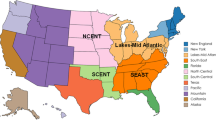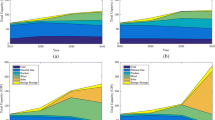Abstract
Climate change tends to negatively affect the power sector, inter alia, by causing cooling problems in power plants and impairing the water supply required for hydropower generation. In the future, when global warming is expected to increase, autonomous adaptation to climate change via international electricity markets inducing reallocations of power generation may not be sufficient to prevent supply disruptions anymore. Furthermore, the consequent changes of supply patterns and electricity prices might cause an undesirable redistribution of wealth both between individual power suppliers and between suppliers and consumers. This study ascertains changes in European power supply patterns and electricity prices caused by on-going global warming as well as the associated redistribution of wealth for different climate change scenarios. The focus of the analysis is on short-term effects. Our results confirm that autonomous adaptation in the power sector should be complemented by planned public adaptation in order to preserve energy security and to prevent undesired distributional effects.







Similar content being viewed by others
Notes
During the 2009-Brazilian blackout, 40 % of the National Interconnected System’s load was interrupted as a consequence of adverse weather patterns (Ordacgi Filho 2010).
Itteilag (2008) states that peak electricity demand in the US, typically for summertime air conditioning, is growing at 2.6 % per year and he discusses options to reduce electricity peaks and to prevent a peak electricity shortfall.
About 43 % of the EU’s water demand is used as cooling water by power authorities (EUREAU 2009: 84).
It should be taken into account that the electricity sector in Europe is not consisting of state-controlled monopolies anymore. Instead electricity supplying companies operate in a liberalised market. Sites for the generation of electricity may be located in another country than the domicile of the supplier owning this site. The attribution of rents to national states where the respective power generation takes place is therefore a simplifying procedure.
Electricity suppliers might also adapt by planned activities, e.g. by improving power plant efficiencies, but might themselves be incapable to reduce the risk of disruptions efficiently. The public sector might support private entities, e.g. by providing better information about climate risks. Individual adaptation is also constrained by institutional processes (Adger et al. 2005: 78).
The power sector may not conduct such adaptation of its own accord because, e.g. it may not hold sufficient information about climate risks and investment cost is high.
References
Adger WN, Arnell NW, Tompkins EL (2005) Successful adaptation to climate change across scales. Global Environ Chang 15(2):77–86
DOE/NETL (2007) Estimating freshwater needs to meet future thermoelectric generation requirements, Pittsburgh
ENTSO-E (2010) Ten-year network development plan 2010–2020, Brussels
ENTSO-E (2011a) Scenario outlook & adequacy forecasts https://www.entsoe.eu/resources/publications/entso-e/saf-soaf/. Accessed 02/03/2011
ENTSO-E (2011b) Consumption data https://www.entsoe.eu/resources/data-portal/consumption/. Accessed 02/03/2011
ENTSO-E (2012) Ten-year network development plan 2012 project for consultation, Brussels
EUREAU (2009) EUREAU statistics overview on water and wastewater in Europe 2008, Brussels
EURELECTRIC (2011) Power statistics, 2010, Union of the Electricity Industry–EURELECTRIC, Brussels
EUROSTAT (2010) Electricity statistics–provisional data for 2009. http://epp.eurostat.ec.europa.eu/portal/page/portal/product_details/publication?p_product_code=KS-QA-10-014
Flörke M, Teichert E, Bärlund I (2011) Future changes of freshwater needs in European power plants. Manag Environ Qual 22(1):89–104
Förster H, Lilliestam J (2010) Modelling thermoelectric power generation in view of climate change. Reg Environ Chang 11(1):211–212
Göransson L, Johnsson F (2009) Dispatch modeling of a regional power generation system–integrating wind power. Renew Energy 34(4):1040–1049
Govindasamy B, Duffy PB, Coquard J (2003) High-resolution simulations of global climate, part 2: effects of increased greenhouse cases. Clim Dyn 21(5–6):391–404
Haddad MS (2011) Capacity choice and water management in hydroelectricity systems. Energy Econ 33(2):168–177
Helm D (2002) Energy policy: security of supply, sustainability and competition. Energ Policy 30(3):173–184
IAEA (2004) Operating experience with nuclear power stations in Member States in 2003, Vienna
IAEA (2008) Operating experience with nuclear power stations in Member States in 2007, Vienna
IEA (2007) Energy security and climate policy–assessing interactions. OECD/IEA, Paris
IEA (2011a) World energy outlook 201,1 OECD/IEA, Paris
IEA (2011b) World energy outlook- investment costs. http://www.worldenergyoutlook.org/investments.asp, Accessed 03/02/2012
IPCC (2007) Climate change 2007: impacts, adaptation and vulnerability. Cambridge University Press, Cambridge
Itteilag RL (2008) Global cooling: electricity peak-shaving techniques to offset climate change. Energ Eng 105(4):66–80
Koch H, Vögele S (2009) Dynamic modeling of water demand, water availability and adaptation strategies for power plants to global change. Ecol Econ 68(7):2031–2039
Kopytko N, Perkins J (2011) Climate change, nuclear power, and the adaptation–mitigation dilemma. Energ Policy 39(1):318–333
Linnerud K, Mideksa T, Eskeland G (2011) The impact of climate change on nuclear power supply. Energy J 32(1):149–168
Mideksa T, Kallbekken S (2010) The impact of climate change on the electricity market: a review. Energ Policy 38(7):3579–3585
Mohseni O, Stefan HG, Erickson TR (1998) A nonlinear regression model for weekly stream temperatures. Water Resour Res 34(10):2685–2692
Morrill JC, Bales RC, Conklin MH (2005) Estimating stream temperature from air temperature: implications for future water quality. J Environ Eng 131(1):139–146
Ordacgi Filho JM (2010) Brazilian blackout 2009, PAC World, March 2010 Issue
Pedersen NL, Sand-Jensen K (2007) Temperature in Lowland Danish Streams: contemporary patterns, empirical models and future scenarios. Hydrol Processes 21(3):348–358
Rübbelke D, Vögele S (2011) Impacts of climate change on European critical infrastructures: the case of the power sector. Environ Sci Pol 14(1):53–63
Seo SN (2011) An analysis of public adaptation to climate change using agricultural water schemes in South America. Ecol Econ 70(4):825–834
Umweltbundesamt (2008) Impacts of climate change on water resources–adaption strategies for Europe, Dessau
Verbruggen A (2008) Windfalls and other profits. Energ Policy 36(9):3249–3251
Webb BW, Clack PD, Walling DE (2003) Water-air temperature relationships in a Devon river system and the role of flow. Hydrol Processes 17(15):3069–3084
World Nuclear Association (2010) Cooling power plants. http://www.world-nuclea.org/info/cooling_power_plants_inf121.html, August 2010
WORLDCLIM (2010) Global climate data. http://www.worldclim.org, June 2010
WWF (2009) Die mögliche Wirkung des Klimawandels auf Wassertemperaturen von Fliessgewässern, Frankfurt am Main
Yongping Y, Rongrong Z, Liqiang D, Masek O, Oakey J (2010) Study on multi-objective optimization of load dispatch including renewable energy and CCS technologies. Int J Energy Res 34(8):702–715
Acknowledgments
We thank Christian Egenhofer, two anonymous referees and the Deputy Editor of this journal, Richard Richels, for their very helpful comments and suggestions.
Author information
Authors and Affiliations
Corresponding author
Rights and permissions
About this article
Cite this article
Rübbelke, D., Vögele, S. Short-term distributional consequences of climate change impacts on the power sector: who gains and who loses?. Climatic Change 116, 191–206 (2013). https://doi.org/10.1007/s10584-012-0498-1
Received:
Accepted:
Published:
Issue Date:
DOI: https://doi.org/10.1007/s10584-012-0498-1




